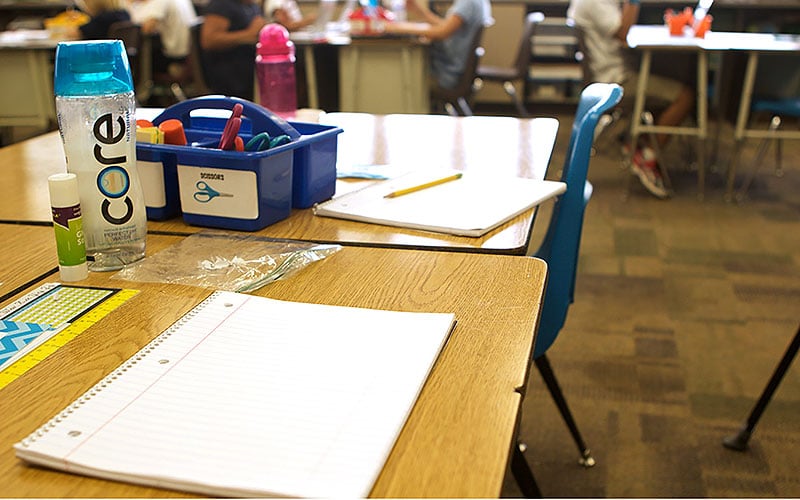- Slug: BC-CNS-Tests Tank,700
- Photo available (thumbnail, caption below)
EDS: A previous version of this story accidentally dropped a word in the penultimate graf. Erin Hart said test scores are not the end-all, be-all. The story below has been corrected, but clients who used earlier versions are asked to run the correction found here.
By Genesis Sandoval
Cronkite News
WASHINGTON – Standardized test scores in Arizona fell across the board last school year, as COVID-19 upended learning through the year and led to a sharp drop in the number of students taking the tests, the Arizona Department of Education said.
Results released by the department Friday showed that 38% of students got “satisfactory” grades on the language test and 31% passed the math test in 2021, compared to 42% for both tests in 2019, the last year for which test results are available.
The department warned that results from the pandemic year “need to be viewed with extreme caution” when compared to other years.
“When considering the results of students who did take the test, it is important to remember the learning disruptions from COVID-19 that may have impacted student learning in unforeseen ways,” the department said in a note released with the data.
It also pointed out that “a significant number of students did not take the test” last year. Close to 740,000 students took both tests in 2019, but just 520,912 took the math test last school year and 511,679 took the language skills test.
The AzM2 test, formerly known as AzMerit, and the Multi-State Alternate Assessment test are given to students in grades three through eight and grade 10. Besides measuring student progress, the AzM2 scores are typically used by the Education Department to assign letter grades to state schools, ranking their performance against others in the state.
But state lawmakers last year suspended the use of the standardized tests for the ranking of schools, while still requiring that the test be administered to students. And Gov. Doug Ducey ordered that the students’ scores still be evaluated to “identify the extent of learning loss” during the pandemic year.
Despite concerns that school administrators and state officials can rely too heavily on standardized test scores to assess school performance, advocates said the results of last year’s tests could prove important.
“Standardized tests are an important piece of data, but outside of a pandemic it still doesn’t tell the full story,” said Erin Hart, senior vice president for Education Forward Arizona. “We over-relied on it as a state. It’s really the only data policymakers and people at the state level have, and it has its importance, but it’s not the end-all, be-all.”
While the drop in test scores is not surprising, Arizona Federation of Teachers President Ralph Quintana said the decline is difficult to measure since there are no test scores from 2020 to compare them with.
“The report isn’t looking at how students have grown between 2020 and 2021,” Quintana said. “Not being able to have growth scores, because students missed a year of testing, severely impacted what we see.”
Declines were seen in all demographic groups, but scores for Black, Latino and Native American students were all below the state average. Quintana said that while all students faced challenges last year, minority students were particularly hard hit.
“It was really hard virtually,” he said of remote schooling. “It’s not surprising that some of these demographics didn’t perform as well as we wanted. Poorer communities weren’t ready for virtual learning. Poor, working class communities lost access to education,”
That was echoed by Hart.
“It’s not just remote learning, but also what kids were dealing with,” she said. “People were experiencing trauma and loss. Kids were sick and quarantined. Some families experienced job loss and weren’t having regular meals. Social isolation as well has affected so many students.”
While the latest numbers are of limited use looking back, Quintana said he hopes they will provide a measure of improvement going forward.
“The real thing will be next year to see if we rebound, if we see growth within these subgroups and communities where they didn’t improve before,” he said.
Hart said the latest scores can be “held in our back pocket” and used to “help students move forward, and how to use COVID funds to help them. But, as she noted, the test scores are not the end-all, be-all.
“Most educators know their kids are much more than a single test score,” she said. “There’s so much more information to see how their kids are doing.”
For more stories from Cronkite News, visit cronkitenews.azpbs.org.
^__=
Web links:
_ AzED data: https://www.azed.gov/accountability-research/data/
_ HB 2402: https://www.azleg.gov/legtext/55leg/1R/bills/HB2402P.pdf
_ Ducey order: https://azgovernor.gov/sites/default/files/eo_2021-03.pdf
^__=
Standardized test scores in Arizona from the last school year fell, a not-unexpected result that was attributed to “learning disruptions from COVID-19” and a sharp drop in the number of grade school and middle school students who were actually present to take the tests. (File photo by James Anderson/Cronkite News)
